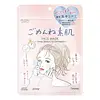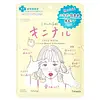What's inside
What's inside
 Key Ingredients
Key Ingredients

 Benefits
Benefits

 Concerns
Concerns

No concerns
 Ingredients Side-by-side
Ingredients Side-by-side

Water
Skin ConditioningButylene Glycol
HumectantDipropylene Glycol
HumectantPPG-10 Methyl Glucose Ether
Skin ConditioningGlycerin
HumectantPrunus Mume Fruit Extract
HumectantPunica Granatum Extract
AstringentTremella Fuciformis Extract
HumectantSchinus Molle Leaf Extract
Skin ConditioningSodium Hyaluronate
HumectantDisodium EDTA
PEG-8
HumectantAcrylates/C10-30 Alkyl Acrylate Crosspolymer
Emulsion StabilisingPEG-50 Hydrogenated Castor Oil Isostearate
EmulsifyingCarbomer
Emulsion StabilisingDiglycerin
HumectantTriethylhexanoin
MaskingSodium Hydroxide
BufferingC14-15 Dialkyl Carbonate
EmollientPhenoxyethanol
PreservativeWater, Butylene Glycol, Dipropylene Glycol, PPG-10 Methyl Glucose Ether, Glycerin, Prunus Mume Fruit Extract, Punica Granatum Extract, Tremella Fuciformis Extract, Schinus Molle Leaf Extract, Sodium Hyaluronate, Disodium EDTA, PEG-8, Acrylates/C10-30 Alkyl Acrylate Crosspolymer, PEG-50 Hydrogenated Castor Oil Isostearate, Carbomer, Diglycerin, Triethylhexanoin, Sodium Hydroxide, C14-15 Dialkyl Carbonate, Phenoxyethanol
Salicylic Acid
MaskingDipotassium Glycyrrhizate
HumectantWater
Skin ConditioningButylene Glycol
HumectantDipropylene Glycol
HumectantSerine
MaskingLactobacillus/Pear Juice Ferment Filtrate
Skin ConditioningCalendula Officinalis Extract
Skin ConditioningNiacin
SmoothingCoix Lacryma-Jobi Ma-Yuen Seed Extract
Skin ConditioningMagnesium Ascorbyl Phosphate
AntioxidantTocopherol
AntioxidantAcrylates/C12-22 Alkyl Methacrylate Copolymer
Disodium EDTA
Xanthan Gum
EmulsifyingDiglycerin
HumectantPolyglyceryl-3 Decyltetradecyl Ether
EmulsifyingDisodium Phosphate
BufferingSodium Hydroxide
BufferingSalicylic Acid, Dipotassium Glycyrrhizate, Water, Butylene Glycol, Dipropylene Glycol, Serine, Lactobacillus/Pear Juice Ferment Filtrate, Calendula Officinalis Extract, Niacin, Coix Lacryma-Jobi Ma-Yuen Seed Extract, Magnesium Ascorbyl Phosphate, Tocopherol, Acrylates/C12-22 Alkyl Methacrylate Copolymer, Disodium EDTA, Xanthan Gum, Diglycerin, Polyglyceryl-3 Decyltetradecyl Ether, Disodium Phosphate, Sodium Hydroxide
 Reviews
Reviews

Ingredients Explained
These ingredients are found in both products.
Ingredients higher up in an ingredient list are typically present in a larger amount.
Butylene Glycol (or BG) is used within cosmetic products for a few different reasons:
Overall, Butylene Glycol is a safe and well-rounded ingredient that works well with other ingredients.
Though this ingredient works well with most skin types, some people with sensitive skin may experience a reaction such as allergic rashes, closed comedones, or itchiness.
Learn more about Butylene GlycolDiglycerin is a humectant. It is derived from glycerin, which is naturally found in your skin.
As a humectant, it helps draw moisture to the skin from the air.
Dipropylene Glycol is a synthetically created humectant, stabilizer, and solvent.
This ingredient helps:
Dipropylene glycol is technically an alcohol, but it belongs to the glycol family (often considered part of the ‘good’ alcohols). This means it is hydrating and gentle on skin unlike drying solvent alcohols like denatured alcohol.
As a masking agent, Dipropylene Glycol can be used to cover the smell of other ingredients. However, it does not have a scent.
Studies show Dipropylene Glycol is considered safe to use in skincare.
Learn more about Dipropylene GlycolDisodium EDTA plays a role in making products more stable by aiding other preservatives.
It is a chelating agent, meaning it neutralizes metal ions that may be found in a product.
Disodium EDTA is a salt of edetic acid and is found to be safe in cosmetic ingredients.
Learn more about Disodium EDTASodium Hydroxide is also known as lye or caustic soda. It is used to adjust the pH of products; many ingredients require a specific pH to be effective.
In small amounts, sodium hydroxide is considered safe to use. However, large amounts may cause chemical burns due to its high alkaline.
Your skin has a natural pH and acid mantle. This acid mantle helps prevent harmful bacteria from breaking through. The acid mantle also helps keep your skin hydrated.
"Alkaline" refers to a high pH level. A low pH level would be considered acidic.
Learn more about Sodium HydroxideWater. It's the most common cosmetic ingredient of all. You'll usually see it at the top of ingredient lists, meaning that it makes up the largest part of the product.
So why is it so popular? Water most often acts as a solvent - this means that it helps dissolve other ingredients into the formulation.
You'll also recognize water as that liquid we all need to stay alive. If you see this, drink a glass of water. Stay hydrated!
Learn more about Water